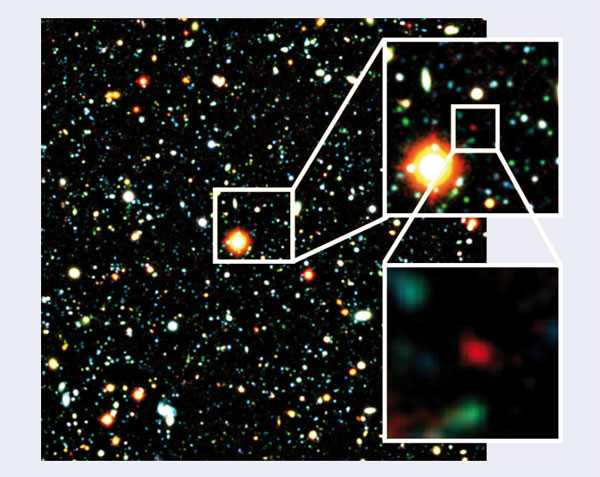Japanese astronomers using the Subaru Telescope in Hawaii have detected the most distant known galaxy in the universe. Light from this source was emitted 780 million years after the Big Bang, at a time when the universe was eight times smaller. The surprise is that such distant galaxies are apparently much less numerous than expected. Are we seeing the very first massive galaxies emerging from the dark ages?

Twenty years ago, the remotest known galaxy was at a redshift z of less than 2. This was pushed back to a redshift of 4.55 ten years later and since 2002 the record redshift was 6.56. Then in 2004 the detection of galaxies amplified through gravitational lensing at z = 7 and even z = 10 was announced (see CERN Courier May 2004 p13).
While the first of these detections has not yet been confirmed spectroscopically, the nature of the second galaxy is still a puzzle, although it is now quite clear that it is not at a redshift of 10.
A new step forward has now been achieved with the definite detection of a galaxy at a redshift of 6.96 by a Japanese team led by Masanori Iye. They found the galaxy with a special filter and camera mounted on the 8.2 m aperture Subaru Telescope at the summit of Mauna Kea on Hawaii. The filter is designed to catch Lyman-alpha emission from star-forming galaxies at a redshift between 6.94 and 7.11. The near-infrared camera has 84 million pixels to cover a relatively wide field of view. Among 41,533 sources detected through this filter only two objects are not detected at shorter wavelengths. Spectroscopic follow-up observations of the brightest of these two sources clearly identified the Lyman-alpha emission line shifted by a factor of z + 1 = 7.96 from its rest wavelength of 121.6 nm to an observed wavelength of 968.2 nm. The second candidate source was too faint to be confirmed spectroscopically.
The detection of only one or possibly two galaxies in this survey is well below the expectation of six sources, based on the number of galaxies observed in the same field at a photometric redshift of 6.6. A similar deficit of high-redshift galaxies was also found by R J Bouwens and G D Illingworth at the University of California Santa Cruz. They found only one candidate galaxy between a redshift of 7 and 8 in the Hubble Ultra Deep Field instead of the 10 expected, based on the galaxies found at a redshift around 6. Both results suggest that very luminous galaxies are rare around 700 million years after the Big Bang.
This is an important result as it gives the timescale needed for the building up of luminous galaxies. According to the polarization measurements of the cosmic microwave background by the Wilkinson Microwave Anisotropy Probe (see CERN Courier May 2006 p12) the first stars in the universe were formed at a redshift of up to 12 or 13 some 300 million years after the Big Bang. Another 400 million years would have been needed to allow small galaxies to merge and form the luminous galaxies we start detecting at a redshift of 7. To detect the fainter galaxies emerging from the dark ages we might have to wait for the launch of the James Webb Space Telescope (JWST) currently scheduled for 2013.
Further reading
R J Bouwens and G D Illingworth 2006 Nature 443 189.
M Iye et al. 2006 Nature 443 186.








